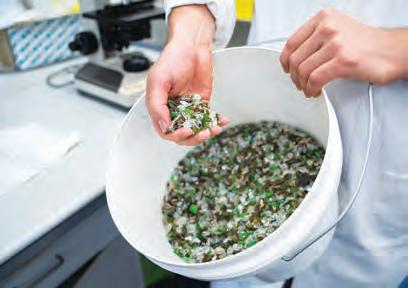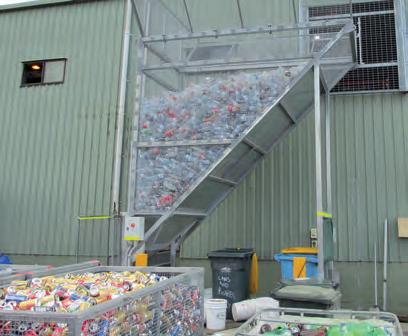
8 minute read
GLASS WASTE TO TOOTHPASTE
UNIVERSITY OF QUEENSLAND RESEARCHERS HAVE DEVELOPED A NEW CHEMICAL PROCESS THAT CAN TURN WASTE GLASS INTO VALUABLE SILICATE PRODUCTS.
Rhys Pirie and his colleague are using a chemical processing method to produce sodium silicate from glass fines.
Glass fines have historically been perceived as a low-grade product.
According to the Glass Packaging Working Group 2018, improved technology allows for increasing amounts of glass fines to be mechanically recovered. However, limited markets for the large volumes of recovered glass which does not meet the quality specifications for glass manufacture has resulted in material being stockpiled.
Researchers at the University of Queensland recently announced they had developed a process that provides glass fines with a high value end market which does not require access to optically sorted cullet streams.
With funding from the Cotton Research and Development Corporation and the Federal Government’s Department of Agriculture and Water Resources, PhD candidate Rhys Pirie and Professor Damien Batsone are using a chemical processing method to produce sodium silicate from glass fines, sidestepping sorting issues and providing significant environmental and economic benefits.
Sodium silicate can be used to manufacture thousands of commodities, from concrete sealers and rubber to toothpaste and detergent, with major end markets being health care, mining, catalysts and silica gel.
Silica gel is a desiccant, meaning it absorbs and holds water vapour. It is the active ingredient in the “do not eat” packet found inside shoe boxes, biscuit packaging, vitamin bottles and a range of other household products that require dry atmospheres.
Rhys estimates the global market for sodium silicate is valued at around $10 billon, or eight million tonnes.
When Rhys and Damien first started working together in October 2017, they were hoping to find a low-cost source of silicon for agricultural fertiliser amendments. They then began to explore different ways to make the silica in glass more available for plant uptake, before realising one of the chemicals they were producing was sodium silicate.
After researching the chemical, the pair noticed a large difference in relative value between silicate and glass fines, suggesting a significant reuse market was being underutilised.
The Department of Environment and Energy’s 2018 National Waste Report shows alternative markets for recycled glass in Australia were undeveloped, which highlights a significant opportunity for expansion.
According to Rhys, fines from waste glass have a value of approximately $10 per tonne when used in roadbase while sodium silicate has a value of less than $1000 per tonne.
Rhys and Damien chemically recycle waste glass by digesting it in an alkaline solution. The reaction products are then processed, with the end result being sodium silicate and silica gel.
Over 4000 hours has gone into experiments optimising the process so that glass can be turned into silicates and then sold to distributors and product manufacturers.
According to Rhys, one kilograms of waste glass can generate more than one kilo of sodium silicate or about 0.75 kilograms of silica gel, meaning the transformation produces very little waste and turns a cost negative waste into an economic resource.
Rhys says traditional sodium silicate production generally uses a furnace process analogous to container glass production, or a high temperature and pressure hydrothermal method. Alternatively, in Rhys and Damien’s extraction method, a large part of the energy and raw material required to make sodium silicate is already embedded in the waste glass.
According to Rhys, utilising the existing energy makes the extraction method 50 per cent cheaper than conventional silicate production processes, which when paired with high-value end use, has potential to provide serious financial reward to the industry.
UniQuest, the University of Queensland’s main commercialisation entity, has filed a patent for the process and is currently initiating discussions with commercialisation partners. Rhys says he and Damien are yet to identify technical or economic limitations which could prevent the process from replacing the majority of sodium silicate production.
Rhys says the process highlights circular economies and high-value reuse.
“The basic concept of circular

The transformation process produces little waste.

economies are difficult to argue against, but often difficult to implement due to economic hurdles. The key to creating successful circular economies is to use the energy and raw materials embedded in ‘waste’ products to make new materials at lower cost – making financial and environmental outcomes complementary, rather than antagonistic,” he says.

Finding the end market
BUNDABERG REGIONAL COUNCIL’S MANAGER OF WASTE AND HEALTH GAVIN CRAWFORD EXPLAINS THE CHALLENGES AND OPPORTUNITIES FOR COUNCIL IN FINDING VIABLE MARKETS FOR RECYCLABLES.
Q. What are some of the challenges surrounding collection and recycling in Bundaberg? A. Currently, our challenges are mainly in the recycling area with the National Sword policy and container refund scheme (CRS) impacting the viability of our material recovery (MRF) facility. The MRF is owned by council and operated by Impact Community Services.
The value of paper commons has dropped by about 70 per cent. Lower grade plastics such as PET fruit and vegetable trays and woven plastic bags used for stockfeed no longer have a market and are not being recycled.
Bundaberg Regional Council was selected to participate in a 12-month trial which commenced in June 2018. The trial was an outcome of the WRIQ Secondary Resources forum, held in Bundaberg in May last year. Residents were advised that some lower grade

plastics, while recyclable, currently had no market, and council was promoting placing these in the waste bin rather than the recycle bin. Council has written to the state and federal environment ministers to raise the issue of market failure for these items.
Q. How is council increasing awareness about recycling in the region? A. To increase awareness about recycling within the region, council has established a Recycle Right campaign. To date, the campaign has included stickers placed on all recycle bins in conjunction with a media push that included social media and print and TV advertising. We also continue to work with Impact Community Services to complete a recycling educational program and conduct audits to reduce contamination and increase recycling. The advertising focuses on recycling plastic bottles and jars, paper and cardboard, aluminium and steel cans, and glass bottles and jars with a clear message.
The results of the trial have indicated there has been a 50 per cent drop in low grade, which don’t currently have a market, being placed in the recycle bins and a 27 per cent decrease in MRF residuals. It is, however, possible that the CRS and the very dry conditions have also contributed to the decrease in residuals.
Impact Community Services has been unable to sell their MRF positively hand-sorted glass since mid-January this year due to an oversupply of CRS glass and limited recycling capacity. Due to the lack of end markets, the MRF glass is now being reprocessed into glass sand in Rockhampton and is being returned to Bundaberg and used internally for council works.
Q. What are you most proud of in your role with council? A. I am most proud of the support the entire Bundaberg waste team has provided to adapt to the many changes in our industry that have occurred over the past five years.
The result has been the increased use of our Bundaberg Regional Landfill which has a fully engineered liner system and gas flaring system, with annual tonnages to landfill increasing from 28,000 in 2013 to 44,000 tonnes per annum this year.
It is also pleasing to see 100 per cent of household wheelie bin waste now disposed of into a lined and engineered landfill, compared to only 72 per cent in 2013 when some older landfills were still in use.
This focus on using our highest quality landfill for acceptance of greater tonnage has also increased the utilisation rate for the Bundaberg Regional Landfill from 504 kilograms per cubic metre in 2012 to 928 kilograms per cubic metre in 2018.
An 84 per cent increase in efficiency was achieved through plant operator commitment, increased tonnages, improved compaction rates, greater use of landfill lids to reduce interim cover used and improvements in stripping the interim cover back between lifts.
Q. Has council ironed out any initial teething problems from the introduction of the QLD levy? A. Council is working with the Department of Environment and Science to iron out any issues and to date they have been very understanding and practical.
Council’s leadership team had the vision to create a two-year waste levy project offficer position, which has allowed council to be successful in the Waste Levy Grants Program and in turn we are prepared for 1 July 2019.
The council has alerted the government of the low market value of some recyclables.

Q. Is there any modern technology the council is utilising and/or would like to use that would make collection more efficient? A. Council is using Ezy2C GPS units in its waste collection fleet and this has allowed routes to be created and saved to increase collections efficiencies. The collection crew is heavily involved in reviews of the routes which occur every two years.

Q. What qualities do you look for in a successful tender and why? A. In my opinion to succeed with a tender you need to ensure there are mainly black and white items and that any grey areas are eliminated as much as possible, as the tenderer will need to make financial contingencies for the grey areas. I also believe you should look at stripping back tenders to cover basic requirements.







